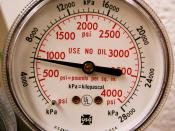Volume:
All gases have to be enclosed in a container that can be sealed with no leaks. The space in that container is the volume. In Chemistry, volume is usually measured in liters or milliliters.
-Whenever units of volume are used, use them all the way through the problem.
In Boyle's law, the volume is a variable. This means that the container involved in the experiment has a movable wall. When the volume goes up, that wall slides out. When the volume goes down, that wall slides in.
If the volume is constant, then the container is made with thick, rigid walls that cannot move. When the pressure is increased, the walls may break thus destroying the experiment. However, within the limits of any experiment, the walls remain fixed and the volume stays constant.
Pressure:
The molecules of gas hitting the walls of the container create gas pressure. This concept is very important in helping you understand gas behavior.
When the generalized variable pressure is used, it will be a symbol "P".
There are three units of pressure used in Chemistry. This is a problem because you have to learn to use all three units.
÷ Atmosphere (symbol: atm)
÷ Millimeters of mercury (symbol: mm Hg)
÷ kiloPascals (symbol: kPa)
Standard pressure is defined as one atm, 760.0 mm Hg, or 101.325 kPa
Amount of Gas:
The amount of gas measured in a container is measured in moles or in grams. When using moles, the symbol is "n".


